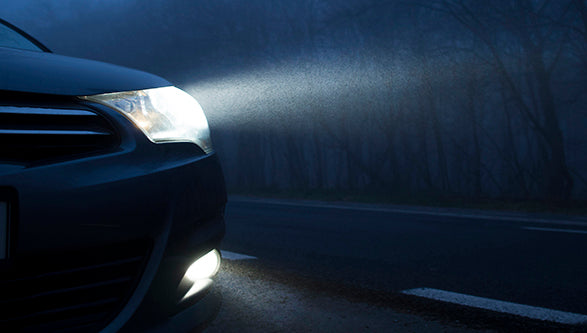When driving, there are many factors that affect our safety and comfort, and the color temperature of the light is one of them. When it comes to the headlights, it can affect how well drivers can see the road and other objects at night or in low-light conditions. When it comes to the interior lighting, it can affect the mood, ambiance, and comfort of the car. Then what's the difference between the color temperature and how to choose it for my car? Read the blog and you'll understand it.
Color temperature is a unit of measure that represents the color component of light. It is measured in degrees Kelvin (K) and ranges from warm to cool. Warm light sources have a lower color temperature (usually around 2700-3000K) and emit a yellowish or reddish glow, while cool light sources have a higher color temperature (usually around 5000-6500K) and emit a bluish-white light.
How is color temperature measured?
- Below 3000K: A light bulb that produces light perceived as amber to yellowish will have a color temperature of around 2700K-3000k. Extremely low color temperature kelvin lights are typically used where infrared spectrum lighting is needed.
- 3000K- 3600K: lights are or used to be one of the most popular color temperatures for stock halogen or incandescent bulbs. These lights are close to the 3000K color of lights, but they have more of a mix of soft white light than that of the yellowish tint. This color temperature is typically what most people want to upgrade from as these color lights appear to be to dim with no light intensity, not to mention the aesthetic reasons of buying and installing the newer types of automotive lights.

- 4000K-4600K: As we start getting above 4000k we start to see the common color temperature of most stock off-road HID light systems. These lights are substantially whiter than that of 3000k-3600k but still have a minute tinge of bright yellow in the mix. If you are looking for that cool to bright whitish blueish color appearance, the 4300K-4600k lights would not be the best selection. You would have to find a light with a color temperature of around 6000k+ if you want to go with the newer modern look.
- 5000K: When the color temperature is 5000K-5600k and/or higher, the light produced ranges from cool to bright white color, sometimes with a light tinge of blue mixed in the light beam.
- 6000K: When you start getting into the 6000 kelvin range and above, you will notice that the color of this lighting appears to be a mix of bright white light and blue light. This color temperature is what you commonly see on newer vehicles that have bluish- whitish automotive lights. Depending on what manufacturer or retailer you purchase your automotive lights or off-road lights, the difference in color temperature can vary drastically, especially when you get into the 5000k + rated lights.
- 7000K: Once you start to get above the 6000K + range in terms of color temperature, you will start to notice that these types of automobile lights have more of a blueish tinge to the color of the light beam. Once again, the higher the kelvin rating, the bluer the light beam appears. Some examples outside the automotive world of lighting, these types of lights would be commonly found and used in places such as jewelry stores, commercial buildings, museums, etc.
- 8000K: Even at 8000k the light appears to be in the color spectrum of lighter blue. These automotive lights are much bluer than the 6000k rated lights, but are still not in the vivid blue range.
- 10000K: 10,000k rated lights produce a dark blue light beam and are in fact, very close to violet in the spectrum(once again, this will depend largely on the light manufacturer). This high of a kelvin rating is uncommon in most automotive and off-roading lighting applications as these lights can actually decrease visibility substantially when driving at night.
- 12,000K: 12000k rated lights are closer to the color violet in terms of the color spectrum and is typically the max threshold for just about any type of on or off-road application.12000k lights in the automotive lights are NOT recommended as a substitute night time driving light.
- 20,000K-30,000K: This high of a kelvin rating is well into the UV spectrum in terms of color temperature and are hardly ever used in practical on and off-road applications. In some instances, 20000k-30000k rated lights are utilized on vehicles when and where ultra-violet lighting is needed.
How to choose LED light color temperature?
When choosing the light color for your car, there are several factors to consider, including your driving needs, personal preference, and the lighting regulations in your area. Here are some tips to help you choose the right light color for your car:
-
Consider your driving needs: If you frequently drive in low-light conditions or in areas with poor visibility, you may want to choose a light color that provides good visibility and clarity, such as a natural white light with a color temperature of around 4300K. If you mainly drive in well-lit areas or during the day, you may prefer a light color that is less bright or more stylish, such as a cooler or warmer light color.
-
Check local regulations: Some areas may have specific regulations regarding the color temperature or brightness of headlights and other vehicle lighting. Be sure to check your local regulations to ensure that your chosen light color is legal and won't result in fines or penalties.
-
Consider your personal preference: Ultimately, the light color you choose should reflect your personal preference and style. Some people prefer cooler light colors, such as blue or white, for a more modern and stylish look, while others prefer warmer light colors, such as yellow or orange, for a more classic or vintage look.
-
Look for high-quality bulbs: Regardless of the light color you choose, it's important to look for high-quality bulbs from reputable brands. Cheap or low-quality bulbs may not provide consistent color temperature or brightness, may not be long-lasting, and may not meet safety standards.
-
Test different light colors: If possible, test different light colors before making a final decision. Many auto parts stores offer display cases where you can compare different bulbs side-by-side to see which one you prefer. Alternatively, you can ask your mechanic or car dealership for recommendations based on your driving needs and preferences.



